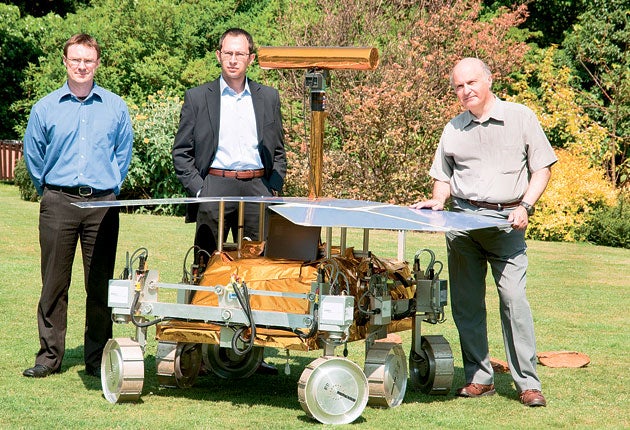Today Leicester. But in 2018... Mars
Could this contraption succeed where the Beagle failed and find extra-terrestrial life?

British scientists have started an ambitious project aimed at searching for signs of extraterrestrial life on Mars, with the help of a sophisticated toolbox of instruments designed to drill deep under the surface of the Red Planet where life may once have thrived.
They have been given the funding and the final go-ahead to design and develop the life-finding instruments that will be transported on board the European Space Agency's (ESA) ExoMars spacecraft, which is scheduled to land on the orange-red soil of our enigmatic planetary neighbour sometime in 2018.
A key feature of ExoMars will be a solar-powered rover vehicle armed with a two-metre long exploratory drill for digging under the harsh, radiation-baked surface of the Red Planet. It is hoped that the instruments embedded in the drill will provide scientists on Earth with the tell-tale signs of life – the fragile chemical or geological signatures left behind by long-dead martian microbes.
"Now that the mission has been confirmed by ESA and the funding has begun to be released by the UK Space Agency, we're actually building the real instruments that will go to Mars in 2018," said Professor Mark Sims of the University of Leicester, which is at the heart of Britain's contribution to the project.
"ExoMars is a key mission in the exploration of planet Mars. It will attempt to gather samples from a depth of one to two metres below the surface where they are protected from radiation and oxidants thought to exist on the surface, both of which would destroy or heavily degrade the complex organic compounds of life," Professor Sims said.
Mars has been a favourite destination for planetary explorers ever since the two Nasa Viking probes landed there in 1976. Although Viking failed to find anything suggesting life on Mars, subsequent research indicated that primitive life may well have evolved on Mars in its distant past, and may even still exist deep under its barren surface.
Britain's effort in Mars exploration climaxed with the 2003 Beagle-2 mission, led by Professor Colin Pillinger of the Open University. Unfortunately the tiny probe was lost during the landing phase, but the legacy of Beagle-2 is that it gave Britain an international lead in the development of instruments for detecting signs of life on other planets, Professor Sims said.
The ExoMars probe, for instance, will carry a Life Marker Chip (LMC), designed by scientists at the University of Leicester, which will detect specific molecules which could indicate past or present life on Mars. This could be the device that ultimately shows that we are not alone in the Universe.
Many experts believe that life may well have arisen independently on Mars within the first billion years of its formation, during the period of its early life when it was warmer and much wetter than it is today. Conditions then on Mars were much like those on the young Earth.
Studies on Earth, where living subterranean microbes have been recovered from several kilometres below ground, support the idea that if life existed in the past on Mars then it is possible for it to have survived into more modern times if it could avoid the harsh conditions on the martian surface.
The ExoMars rover, named Bridget after its prototype initials "BB", will be built by the British satellite company Astrium. All the samples it will analyse for signs of life will be extracted by a drill, which will be embedded with instruments designed to detect such things as the organic molecules left behind by microbes, or any microscopic fossil formations produced by these lifeforms.
ExoMars, which involves an orbiting spacecraft to be launched in 2016 followed by a second landing craft and rover vehicle in 2018, is part of the bigger Aurora mission of ESA, aimed at exploring the wider Solar System.
Missions to the Red Planet
Viking (1976)
Nasa's Viking mission consisted of two spacecraft, each made up of an orbiter and a lander. The two landers successfully touched down softly on Mars and sent back the first stunning images of the martian landscape. Much of the data from these Viking landers provided the most accurate source of information on the Red Planet for the next 20 years. However, Viking failed to find any signs of life, and the barren landscape only reinforced the idea that Mars had always been a lifeless, empty place.
Beagle-2 (2003)
A small, innovative and relatively cheap mission named after the ship that carried Charles Darwin on his voyages of discovery. Beagle-2 was the brainchild of Professor Colin Pillinger, of the Open University, and was designed to land on Mars with the help of parachutes and giant, inflatable bags to cushion the fall of the small probe. It was packed with instruments to look for the tell-tale signs of life, but unfortunately, it was lost during the precarious descent through the thin martian atmosphere. Beagle-2 nevertheless demonstrated that British scientists can be important players in planetary exploration.
Mars Exploration Rover (2004)
Two sophisticated and highly expensive Nasa rovers, named Spirit and Opportunity, carried out successful explorations of Mars using instruments designed primarily to look at the planet's geology. Neither of the rovers, however, were equipped to find evidence of life or to be fossil hunters. Both rovers lived far beyond their design lifetime. They gathered amazing images of the Red Planet and signs that water once ran on its dust-strewn surface.
Subscribe to Independent Premium to bookmark this article
Want to bookmark your favourite articles and stories to read or reference later? Start your Independent Premium subscription today.

Join our commenting forum
Join thought-provoking conversations, follow other Independent readers and see their replies